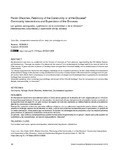Parish Churches, Patrimony of the Community or of the Diocese?. Community Interventions and Supervision of the Dioceses

Ver/
Use este enlace para citar
http://hdl.handle.net/2183/25391
A non ser que se indique outra cousa, a licenza do ítem descríbese como Atribución-NoComercial 3.0 España
Coleccións
Metadatos
Mostrar o rexistro completo do ítemTítulo
Parish Churches, Patrimony of the Community or of the Diocese?. Community Interventions and Supervision of the DiocesesTítulo(s) alternativo(s)
Las iglesias parroquiales, ¿patrimonio de la comunidad o de la diócesis?. Intervenciones comunitarias y supervisión de las diócesisAutor(es)
Data
2020Cita bibliográfica
Zito, Carla. 2019. «Las Iglesias Parroquiales, ¿patrimonio De La Comunidad O De La diócesis?». Actas De Arquitectura Religiosa Contemporánea 6 (diciembre), 182-93. https://doi.org/10.17979/aarc.2019.6.0.6238
Resumo
[Abstract] My intervention was born as a reflection on the Census of churches of Turin diocese, organized by the CEI (Italian Episcopal
Conference). Through my studies, I’ve observed the case of Turin ecclesiastical heritage built in the second half of the
20th century. A great number of places of worship have changed their historical validity due to arbitrariness of choices and
interventions.
I’ve always supported the thesis that this religious buildings are an important patrimony for the urban history and expression
of the pastoral liturgy of the diocese in Italy and that the community is fundamental to the birth and the management of a parish
centre. Now I think that it is necessary to consolidate project strategies and fix best-practices to preserve the ecclesiastic
heritage from everyone’s action.
Generally speaking, what contemporary buildings can be part of the Church heritage? How far can priests and communities
decide, independently, to intervene? [Resumen] Mi intervención nació como una reflexión sobre el Censo de las iglesias de la diócesis de Turín, organizado por la CEI (Conferencia
Episcopal Italiana). A través de mis estudios, he observado el caso del patrimonio eclesiástico turinés construido en
la segunda mitad del siglo XX. Un gran número de lugares de culto han cambiado su validez histórica debido a la arbitrariedad
de las elecciones e intervenciones.
Siempre he sostenido la tesis de que estos edificios religiosos son un patrimonio importante para la historia urbana y expresión
de la liturgia pastoral de las diócesis en Italia, y que la comunidad es fundamental para el nacimiento y la gestión de
un centro parroquial. Ahora pienso que es necesario consolidar las estrategias de los proyectos y fijar las mejores prácticas
para preservar el patrimonio eclesiástico de la acción de todos.
En general, ¿qué edificios contemporáneos pueden formar parte del patrimonio de la Iglesia? ¿Hasta qué punto pueden los
sacerdotes y las comunidades, de manera independiente, intervenir?
Palabras chave
Community
Heritage
Parish churches
Arbitrariness
Ecclesiastical legislation
Comunidad
Patrimonio
Iglesias parroquiales
Arbitrariedad
Legislación eclesiástica
Heritage
Parish churches
Arbitrariness
Ecclesiastical legislation
Comunidad
Patrimonio
Iglesias parroquiales
Arbitrariedad
Legislación eclesiástica
Versión do editor
Dereitos
Atribución-NoComercial 3.0 España
ISSN
2340-5503






